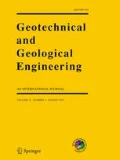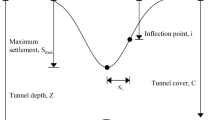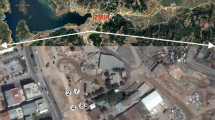Abstract
Borehole extensometers are commonly utilized in field monitoring programs to measure settlement. In order to secure the targets of the extensometer, the borehole is typically backfilled with cement-bentonite grout. In the absence of standards for grout mix designs and due to non-universality of the properties of the backfilling grout, the accuracy of settlement furnished by borehole extensometers may be questionable. A preliminary parametric study was conducted to investigate the influence of grout stiffness on settlement measurements using borehole extensometers. The finite element program ABAQUS was used to model a borehole extensometer installed in an isotropic homogeneous elastic soil layer of a finite depth subjected to a uniform surface surcharge. Effect of the grout–soil elastic moduli ratio, soil/grout interface parameters (friction angle and shear strength), and extensometer embedment depth were investigated. Soil/grout interface behavior was assumed to comply with the elastic-perfectly plastic Coulomb friction model. The mechanism of measuring settlement using borehole extensometers was studied. The numerical study revealed that minimum errors in settlement can be obtained if the grout–soil elastic moduli ratio is made equal to about 1.0. Depending on the grout–soil moduli ratio, larger grout/soil interface friction angle and interface shear strength are generally associated with smaller settlement errors. Compared to fully embedded extensometers, partial embedment yields smaller settlement errors for grout–soil moduli ratio significantly above unity. In view of the findings of this preliminary parametric study, it is suggested to adopt the grout–soil moduli ratio in conjunction with grout compressive strength as the controlling criterion rather than the grout compressive strength only (current standard of practice). Additionally, it is evident that cement-bentonite grout mix should be carefully designed as part of the settlement monitoring programs to match the expected deformability (stiffness) of the soil mass under consideration. Future laboratory, field and numerical studies are needed to investigate more complex soil stratifications and to evaluate the behavior of various grout mixes.










Similar content being viewed by others
References
ABAQUS (2006) ABAQUS/Standard version 6.6, User’s manual and theory manual. Hibbit, Karlson and Sorensen Inc, USA
Arya S, Hegemier G (1982) Finite element method for interface problems. Proc Am Soc Civil Eng(ASCE) J Struct Div 108(ST2): 327–343
Avalle DL, Kay JN (1986) Prediction and performance of a shallow footing for a multi-story building on stiff clay, Institution of Engineers, Australia, 86/8, ISBN 08583097, 6–9
Bayoumi A (1999) Numerical assessment of the effects of grout characteristics on settlement measurements in Borehole Extensometers, M.S. Dissertation, Engineering Department, The American University in Cairo, Cairo, Egypt
Blackburn JT (2002) Finite element analysis of TDR sensor cable-grout-soil mass interaction during localized shearing, M.S. Thesis, Department of Civil and Environmental Engineering, Northwestern University, Evanston, IL, USA, April
Brummund WF, Leonards GA (1973) Experimental study of static and dynamic friction between sands and typical construction materials. J Test Eval 1(2):162–165
Burland JB, Moore JAF, Smith PDK (1972) A simple and precise Borehole Extensometer. Geotechnique 22:174–177
Cook R, Malkus D, Plesha M, Witt R (2002) Concepts and applications of finite element analysis, 4th edn. Wiley and Sons Inc, New York, p 719
Dowding CH, O’Connor KM (2000) Comparison of TDR and inclinometers for slope monitoring. In: Marr WA (ed) Proceedings of the GeoDenver 2000. ASCE Special Technical Publication No. 106, Reston, VA
Dunnicliff J, Green G (1988) Geotechnical instrumentation for monitoring field performance. Wiley and Sons Inc, New York, p 577
Edil TB, Abdel Rahman MA (1993) Shaft resistance of model pile in granular soil. In: Van Impe WF (ed) Deep foundation on Bored and Auger Piles. A. A. Balkema, Rotterdam, pp 279–284
Faruque M (1986) An axisymmetric interface element for soil-structure interaction problems. In: Selvaduri A, Voyiadjis G (eds) Proceedings of the Technical Sessions Held at the ASCE/ASME Mechanics Conference, Engineering Mechanics Division, Albuquerque, New Mexico, June 1985, pp 189–201
Gens A, Alonso E (1988) An interface element formulation for the analysis of soil-reinforcement interaction. Comput Geotech 7:133–151
Majano R, O’Neill M (1993) Effect of dosage exposure time of Slurries on Perimeter load transfer in Bored Piles. In: Van Impe WF (ed) Deep foundation on Bored and Auger Piles. A. A. Balkema, Rotterdam, pp 207–212
Marsland A (1973) Discussion, principles of measurement. In field instrumentation in geotechnical engineering, British Geotechnical Society, Halsted Press, A Division of John Wiley, pp 531–532
Marsland A, Quarterman R (1974) Further developments of multipoint magnetic extensometers for use in highly compressible grounds. Geotechnique 24(3):429–433
Meyerhof G (1976) Bearing capacity and settlement of pile foundations. Proc Am Soc Civil Eng (ASCE),J Geotech Eng Div 102(3): 197–228
Mikkelsen PE (2002) Cement-Bentonite grout backfill for Borehole instruments. Geotech Instrum News 20(4):38–42
Mikkelsen PE, Green GE (2003) Piezometers in fully grouted Boreholes, Symposium on field measurements in geomechanics, FMGM 2003, Oslo, Norway, September, pp 545–553
Mossaad M, Sayed SA, Cutler J, Ghoneim H (1996) Study, design and construction supervision of a pilot groundwater drainage project, Kuwait Institute for Scientific Research, Report No. KISR4794, Kuwait
Peiffer H, Van Impe W (1993) Evaluation of pile performance based on soil stress measurements- field test program. In: Van Impe WF (ed) Deep foundation on Bored and Auger Piles. A.A. Balkema, Rotterdam, pp 385–389
Potyondy JG (1961) Skin friction between various soils and construction materials. Geotechnique 11(4):339–353
Poulos H, Davis E (1980) Pile foundation analysis and design. Wiley and Sons Inc, New York, p 397
Terzaghi K, Peck RB, Mesri G (1996) Soil mechanics in engineering practice, 3rd edn. Wiley and Sons Inc, New York, p 592
Tomlinson MJ (1987) Pile design and construction practice. Viewpoint Publishers, London, p 411
Vaughan PR (1969) A note on sealing Piezometers in Boreholes. Geotechnique 19(3):405–413
Vaughan PR (1973) Discussion, principles of measurement in field instrumentation in geotechnical engineering, British Geotechnical Society. Halsted Press A Division of John Wiley, London, pp 542–543
Will D (1997) Cement Bentonite grouts compatible with compliant TDR cables, M.S. Thesis, Department of Civil and Environmental Engineering, Northwestern University, Evanston, IL, USA, December
Acknowledgments
The author would like to extend his thanks and appreciation to Mr. Bill Moler of URS for the careful review of the manuscript, and the invaluable technical feedback. The author owes a special acknowledgement to Dr. Reda Bakeer of Ardaman and Associates, Inc. for critically reviewing the revised manuscript.
Author information
Authors and Affiliations
Corresponding author
Rights and permissions
About this article
Cite this article
Bayoumi, A. On the Evaluation of Settlement Measurements Using Borehole Extensometers. Geotech Geol Eng 29, 75–90 (2011). https://doi.org/10.1007/s10706-010-9352-2
Received:
Accepted:
Published:
Issue Date:
DOI: https://doi.org/10.1007/s10706-010-9352-2




